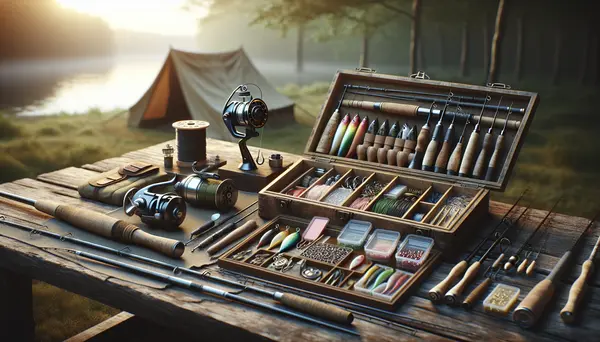Table of Contents:
Introduction to Fishing Tackle
Welcome, budding anglers! If you're new to the world of fishing and feeling a bit overwhelmed by all the gear options out there, don't worry. This beginner's guide will help demystify href="https://forum.buzzerfish.com/the-must-have-fishing-gear-choosing-the-right-fishing-bucket/">fishing tackle, making your first steps into this exciting hobby much easier.
Understanding What is Fishing Tackle?
href="https://forum.buzzerfish.com/understanding-fishing-gear-codes-a-starter-s-guide/">Fishing tackle refers to any equipment used for fishing. It includes rods, reels, lines, hooks, sinkers (weights), floats (bobbers), lures or baits - basically everything that helps you catch fish. Each piece has its own purpose and knowing how they work together can greatly improve your chances of landing a big one!
Pros and Cons of Fishing Tackle for Beginners
| Pros | Cons |
|---|---|
| Affordable to start | Can become expensive with upgrades |
| Widely available | Can be confusing to choose the right one |
| Easily adjustable based on fish types | Requires deep understanding for optimization |
| Enhances fishing activities | Potential hazardous to nature if not properly disposed |
| Encourages learning and experimentation | Potential for loss/damage |
The Basics: Rods and Reels
Your rod and reel are arguably the most important pieces of your fishing tackle setup. The rod provides leverage when casting out line while the reel controls how far it goes and retrieves it back in.
Rods come in various lengths depending on what type of fishing you plan on doing. Shorter rods offer more control over casts but limit distance; longer ones allow for further casts but require more skill to handle effectively.
Reels also vary based on their design with three main types being spinning reels, baitcasting reels and fly-fishing reels. Spinning reels are generally easiest for beginners due to their simple operation.
Hooks: Catching Your Fish
No matter what kind of bait or lure you use if it doesn’t have a hook attached then catching anything becomes impossible! Hooks come in different sizes according to species targeted so make sure choose appropriately sized ones each time go out water.
Bait vs Lure:
Fishing tackle and bait are two terms often used interchangeably, but they're not the same thing. Bait refers to substances you attach to your hook to attract fish - this could be anything from worms and insects for freshwater fishing, or squid and shrimp for saltwater species.Lures on the other hand are artificial baits designed to mimic real prey. They come in a wide variety of shapes, sizes and colors with each type being effective under different conditions or for specific types of fish.
The Role of Lines, Sinkers & Floats
Your line is what connects everything together; it's attached at one end to your reel and at the other end holds your hook (and any lures or bait). Line strength should match both target species weight as well rod/reel capabilities avoid breakages during fights!
Sinkers help weigh down lines so that hooks can reach deeper waters where bigger fishes might dwell while floats keep them near surface when targeting those swimming closer top – these also serve as visual indicators bites making easier know when strike set catch securely onto gear.
Packing Your Tackle Box: Essential Items
Apart from aforementioned items there few more essentials every angler should have their fishing tackle box. These include pliers cutting loose ends off knots tying new ones if needed; spare hooks case lose original ones during outing; extra sinker weights varying depths want explore etcetera! Remember always pack according expected conditions location plan visit maximize chances success out water.
Conclusion:
In conclusion, understanding how various pieces of fishing tackle work will greatly enhance your experience on the water. It may seem overwhelming initially but remember everyone starts somewhere! With time practice soon become second nature handling all equipment like pro reeling big catches no time. Happy fishing!Frequently Asked Questions About Beginner's Fishing Tackle
What is fishing tackle?
Fishing tackle refers to the equipment used by anglers while fishing. It typically includes rods, reels, lines, hooks, sinkers, baits, lures, spears, nets, gaffs, traps, waders and tackle boxes.
How do I choose my first fishing rod?
When choosing your first fishing rod, consider your fishing environment, target species, and fishing style. For beginners, a medium-power, medium-action spinning rod is often a good choice as it's versatile and easy to handle.
What is the importance of fishing line?
The fishing line is a crucial part of fishing tackle as it connects the angler, rod, and the bait or lure to the fish. It needs to be strong enough to withstand the weight of the fish and abrasive enough to resist damage from the fish's mouth or underwater objects.
What is the role of baits and lures in fishing?
Baits and lures play vital roles in attracting the fish. Baits, which can be live or dead, exude a scent that fish find enticing. Lures, on the other hand, mimic the look and movement of the fish's prey, enticing the fish to bite.
What should I include in my tackle box as a beginner?
As a beginner, your tackle box should include essential items such as extra line, hooks of different sizes, a few lures, bobbers, a few split shot sinkers, needle nose pliers, a knife, and first aid supplies.







